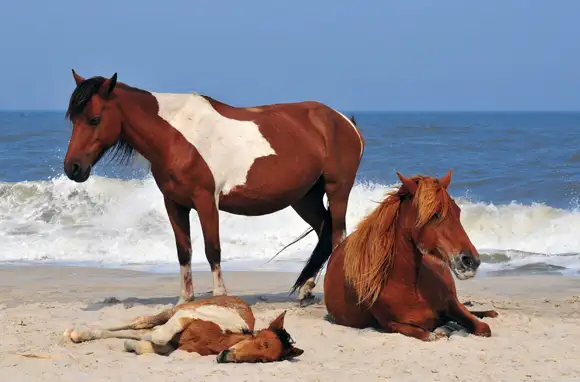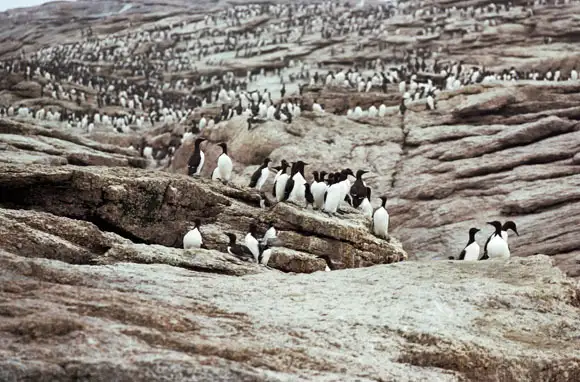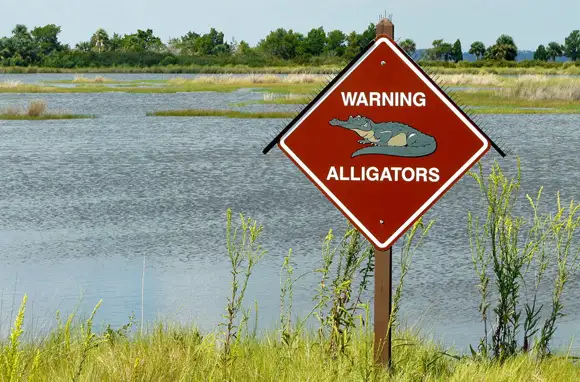
To see the country’s most incredible wildlife, you don’t have to head to a national park. Black bears, buffalo, alligators, and other cool creatures take up residence in the protected habitats of 556 national wildlife refuges across America. Lace up your hiking boots. This stateside safari takes you to 10 of the best refuges for spotting wildlife, from Florida’s alligator swamps to Alaska’s Arctic tundra, with stops to see migrating butterflies, moose-trodden wetlands, and more.
Before venturing out, download the refuge system’s new mobile app, MyRefuge, with GPS-enabled maps and attraction information.
Like this story? Join the 1 million other travelers who read our free Deal Alert newsletter. It’s full of our best tips, trip ideas, and travel deals. Subscribe here today!
Image Gallery

Kilauea Point National Wildlife Refuge
Life is beautiful at this refuge along Kauai's rugged northern coast. Below Kilauea Point's volcanic cliffs, Hawaiian monk seals haul out on rocks, humpback whales spout and breach, and spinner dolphins play. This gorgeous spot is also the locale for one of Hawaii's largest gatherings of nesting seabirds. At the Kilauea Lighthouse, watch the elaborate aerial courtship displays of the great frigate bird and the Laysan albatross, whose stunts range from backward flying to bill clapping. The refuge is also home to the endangered nene goose, Hawaii's state bird.
Best Time to Go: Humpback whales migrate January through March.

Kilauea Point National Wildlife Refuge
Life is beautiful at this refuge along Kauai's rugged northern coast. Below Kilauea Point's volcanic cliffs, Hawaiian monk seals haul out on rocks, humpback whales spout and breach, and spinner dolphins play. This gorgeous spot is also the locale for one of Hawaii's largest gatherings of nesting seabirds. At the Kilauea Lighthouse, watch the elaborate aerial courtship displays of the great frigate bird and the Laysan albatross, whose stunts range from backward flying to bill clapping. The refuge is also home to the endangered nene goose, Hawaii's state bird.
Best Time to Go: Humpback whales migrate January through March.

Kofa National Wildlife Refuge
Spread across 650,000 acres of Sonoran Desert near Yuma, Arizona, Kofa is home to 400 bighorn sheep. You'll see them traversing the impossibly steep slopes of the refuge's two canyons, which are accessed by 300 miles of dirt roads or by blazing your own hiking trail. Kofa is one of the few refuges that allows camping, and you can pitch a tent most anywhere for a night of incredible stargazing. Eighty percent of the reserve is considered wilderness, far from city lights.
Best Time to Go: If you can stand the desert heat, August is when rams are in rut, banging their horns together and fighting over ewes.

Chincoteague National Wildlife Refuge
This Assateague Island refuge off Virginia's coast is one of the most visited in the country. The National Audubon Society named it a top 10 birding hot spot, as more than 320 species have been spotted there. Crabbing, clamming, and beach campfires also bring weekend crowds. But Chincoteague is best known for its wild ponies, descended from horses presumed to have swum ashore from Spanish galleons that sank off the coast in the 15th and 16th centuries.
Best Time to Go: Birding peaks in spring and summer. The annual pony swim to and from Chincoteague Island happens at the end of July. You can tour the historic Assateague Lighthouse daily June through October or on weekends in spring and fall.

Oregon Islands National Wildlife Refuge
Oregon's iconic sea stacks and offshore islands aren't a big draw for only film crews and photo-snapping vacationers; they're also a magnet for wildlife. More than 1.2 million seabirds pack onto practically every available inch of this refuge's 1,400 rocks, reefs, and tiny islands during breeding season. Each year 700 to 800 Steller's sea lions are born in the refuge's Rogue and Orford Reef areas. At Coquille Point you can often see tufted puffins, common murres, and harbor seals. Observe from a viewing deck or descend the staircase to explore tidepools on the beach.
Best Time to Go: Shorebird breeding season peaks April through August.

Rocky Mountain Arsenal National Wildlife Refuge
This prairie is one of the country's most accessible wildlife refuges, just 10 miles from downtown Denver. Near the entrance, deer lounge under trees and prairie dogs and owls peek out of burrows. Most visitors, though, come to see the bison herd that was introduced at Rocky Mountain Arsenal in 2007. You'd never guess that two decades ago this was the toxic site of a U.S. Army-run chemical-weapons plant. The refuge's new visitor center offers hands-on activities and an interesting look at the Superfund site cleanup.
Best Time to Go: July is rutting season, when male bison butt heads and push each other around. Calves are born May through November.

St. Marks National Wildlife Refuge
Watch your toes. At this swampy wildlife refuge 25 miles south of Tallahassee, alligators can reach lengths of 14 feet. It's unusual not to spot them here in the marshes along the road to the 1832 St. Marks Lighthouse on Apalachee Bay. Photographers say the lighthouse is the best place to snap shots of hordes of monarch butterflies during the butterflies' annual migration in October. Whooping cranes and more than 300 other bird species stop over at St. Marks, and 98 species nest on-site.
Best Time to Go: In May watch for large groups of West Indian manatees in the waters near the lighthouse. Baby alligators emerge from nests in August. See the monarchs in October.

Agassiz National Wildlife Refuge
Two packs of Minnesota's eastern gray wolves live at Agassiz, in the state's northwest corner. With a bit of luck, you'll catch a glimpse of the elusive creature darting across the road, running through a short grassy area, or crossing a lake or pond on the ice. Even if wolf spotting is a bust, you won't leave disappointed. Several pairs of bald eagles nest on the refuge, and the observation deck over the wetlands offers a great view of one eagle nest that gets used every year.
Best Time to Go: You're more likely to see wolves in summer. Spring and fall are the best times to see eagles.

Bosque Del Apache National Wildlife Refuge
Every autumn, visitors flock to Bosque del Apache near the Rio Grande in New Mexico to witness one of the country's greatest birding spectacles: the noisy return of tens of thousands of sandhill cranes and snow geese. The Festival of the Cranes spans six days in November, but the birds stick around through early March. You can watch the massive fly-outs and fly-ins as the cranes and geese leave their roost sites each day at sunrise and return at sunset. The surrounding foothills, mesas, and mountains provide a stunning backdrop for photography.
Best Time to Go: The annual Festival of the Cranes runs November 13 through 18 and has tours, photography workshops, and kids' activities.

Aroostook National Wildlife Refuge
If you're looking for wildlife that's bigger and hairier than you, Aroostook refuge near the Maine North Woods is the place. Aroostook County claims the densest population of moose and black bears in the Lower 48, and sightings are common May through September at the county's wildlife refuge near Limestone. Until 1998 the refuge was a U.S. Air Force base with a top-secret base-within-a-base.
Best Time to Go: In summer you can book a free tour to see the 53 Cold War-era nuclear weapons bunkers. In fall the antlers of bull moose are fully formed. In winter the refuge grooms its trails for cross-country skiing and snowshoeing.

Arctic National Wildlife Refuge
Few visitors ever make the trip to the roadless expanse that is Alaska's Arctic National Wildlife Refuge. Roughly the size of South Carolina, it's one of the world's most remote natural areas. You can hire an air taxi to get you there and a guide to help you set up camp and navigate rivers or alpine tundra. See a herd of 120,000-plus Porcupine caribou sweep across the coastal plain or watch polar bears hunt seals in spring.
Best Time to Go: See the caribou migration May through July. Grizzlies emerge in spring and early summer to feed on salmon in coastal rivers. Salmon spawning typically peaks in August.
More From Smartertravel:
We hand-pick everything we recommend and select items through testing and reviews. Some products are sent to us free of charge with no incentive to offer a favorable review. We offer our unbiased opinions and do not accept compensation to review products. All items are in stock and prices are accurate at the time of publication. If you buy something through our links, we may earn a commission.
Related
Top Fares From
Today's Top Travel Deals
Brought to you by ShermansTravel
12-Night Peru Escorted Tour, Incl. Sacred...
Wingbuddy
 vacation
$2198+
vacation
$2198+
16-Night Hawaiian Islands Cruise Over Christmas...
Princess Cruises
 cruise
$1579+
cruise
$1579+
Ohio: Daily Car Rentals from Cincinnati
85OFF.com
 Car Rental
$19+
Car Rental
$19+



